The Razer Blade Stealth Review: Razer Takes On The Ultrabook
by Brett Howse on March 29, 2016 8:00 AM EST- Posted in
- Laptops
- Razer
- Skylake
- Razer Blade Stealth
- eGFX
- Razer Core
- Skylake-U
Battery Life
Mobility goes hand-in-hand with battery life. The Razer Blade Stealth certainly fits the mobility part, with a small, thin, and light design which would be easy to take with you. But if you have to bring the charger with you, it’s less convenient. We’ve seen some impressive battery life numbers on Ultrabooks and other low-profile devices over the last couple of years, with the Dell XPS 13 and Microsoft Surface Book both hitting over 15 hours on our light test.
The Stealth has a slightly smaller than average battery size, at 45 Wh. I would say the average for an Ultrabook of this size would be around 50 Wh, with a couple below and a couple above. This is going to be a factor against the Stealth right out of the gate. The other factor against it is the high resolution display offerings. Baseline Ultrabooks generally come with a 1920x1080 display, and the lowest offered on the Stealth is a 2560x1440. The top model is 3840x2160, or four times the pixels of a 1080p display. This not only is more work to render images on for the GPU, the transistors used to drive the pixels also block the backlighting, necessitating a brighter, more power-hungry backlight.
We measure battery life with two standardized tests. The light test is simply web browsing, with the display set to 200 nits brightness. The heavy test loads many more pages, adds in a movie playback, and includes a 1 MB/s file download to keep the wireless NIC active. For 2016, these tests may be adjusted, but for now the existing tests give us lots of data points against previously tested devices. All browsing is done with Microsoft Edge as the browser, and keyboard backlighting is disabled.
Light Battery
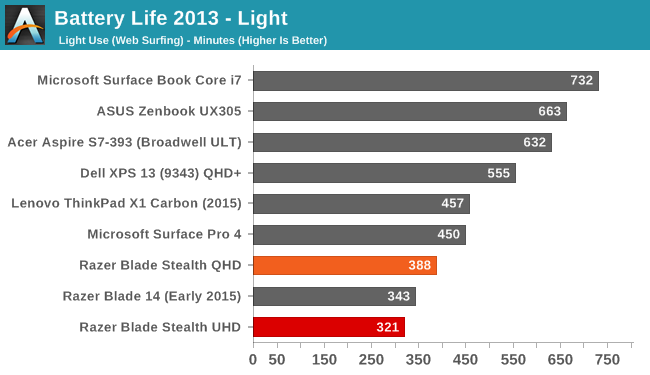
This, well there’s no way to sugar coat this. This is poor battery life for an Ultrabook in 2016. The UHD model unsurprisingly suffers even more than the QHD version, but both are below average. At just about 6.5 hours on the QHD one, it is getting very close to the same battery life as the Razer Blade 14, which is a full-fledged gaming notebook. The UHD model is 67 minutes less. If you are after the ultimate in mobility, then the Razer Blade Stealth is not the notebook for you.
Heavy Battery
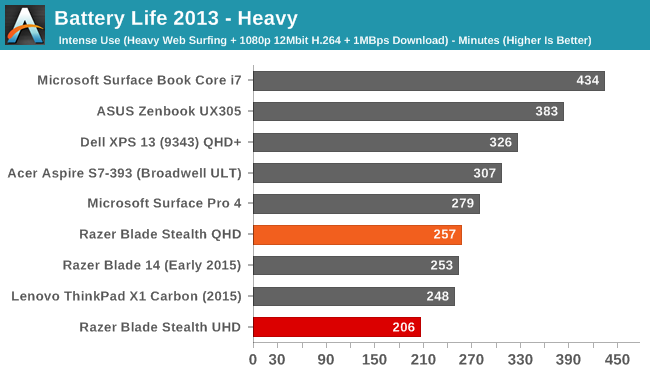
Adding in more CPU, NIC, and GPU shifts the balance on power draw away from the display, which is the main power draw on the light test. This pulls the UHD model a bit closer to the QHD version, with it only 51 minutes behind this time. But regardless, these heavy load times are far from the top of the Ultrabook class.
Normalized Battery Life

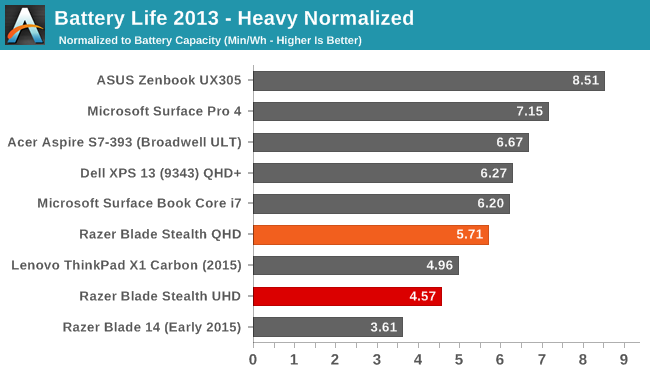
Removing the battery size from the equation gives us a better look at platform efficiency, since low efficiency can’t be masked by larger battery sizes in these scores.
The Stealth clearly has some work to do on efficiency. The best devices in the Ultrabook category can be in the 10-14 minutes per Watt-Hour range on the light test, and even the QHD version of the Stealth is only at 8.6. On the heavy test, it fares a bit better, but is still below the other devices.
This is Razer’s first kick at the can when building an Ultrabook. On the Razer Blade 14, the battery life is pretty decent for a gaming laptop. There are plenty of high draw components like a discrete GPU and quad-core processor to mask smaller inefficiencies of the platform. But, when looking at Ultrabooks, Razer is up against some of the biggest OEMs out there, and whom all are trying for that elusive top battery life score. There are missteps by the OEMs too, such as Dell having an issue with NVMe storage not going to sleep, which was later fixed with a BIOS update, but Razer needs to look at their platform at a component by component basis, and strive for better. Getting six or so hours out of a gaming notebook like the Blade 14 is pretty decent, but an Ultrabook in 2016 needs to be at least eight.
As an experiment, the Stealth was left running idle at the desktop at 200 nits, with just a script running to log the time every two minutes. Here it only got just 8:17, barely a squeak over eight hours, and this is with it doing nothing at all. Not everyone needs long battery life, but it’s going to be on a lot of people’s list when considering a notebook, so hopefully this will be addressed for future models.
Charge Time
The other half of the equation is charge time. This is generally limited by the AC adapter shipped with the device. In this case, that’s a 45-Watt adapter, and Razer uses the USB-C port as the charging port. The design of the charger is quite nice too, with a braided cord on the USB end and a very small adapter. One issue I’ve had with the charger though is that there is noticeable coil whine from the adapter, especially when the laptop is charged but plugged in. I’ve actually got three adapters, and all of them have some coil while, although one of them is significantly louder than the others.
Moving on the charging times, the charging time test is done with the machine idle at the desktop, and the display set to 200 nits again. Charge times are from whatever the laptop shuts off at (generally 5% battery) to 100% charge. Most devices charge pretty quickly up to 99%, and then trickle charge the last percent, so a charge graph is provided as well.
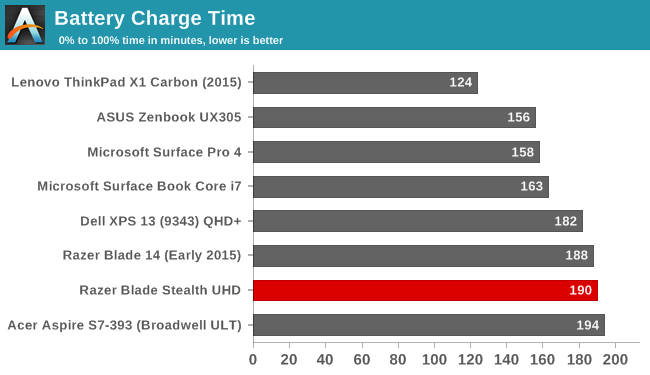
At 190 minutes, the Stealth is amazingly right around the same time as the Blade 14. The similarities seem to never end, but the result is below average but not a huge amount.
It’s great to see Razer go with a USB-C charging cable. For most laptops, the 100-Watt power availability from USB-C is going to be enough, meaning there’s a good chance laptop cords will finally be universal. In fact, it’s very convenient that I can already charge this laptop with the same cord that I use for my phone, and vice versa, and especially when travelling it’s nice to see a move to a standard charging connector.
This section is not the strongest part of the Stealth. Battery life has been sub-par and the charging speed is below average as well, and compounded by a power supply that is not inaudible. It’s well designed aesthetically but the coil whine is annoying to the point where I disconnect the laptop when its charged.


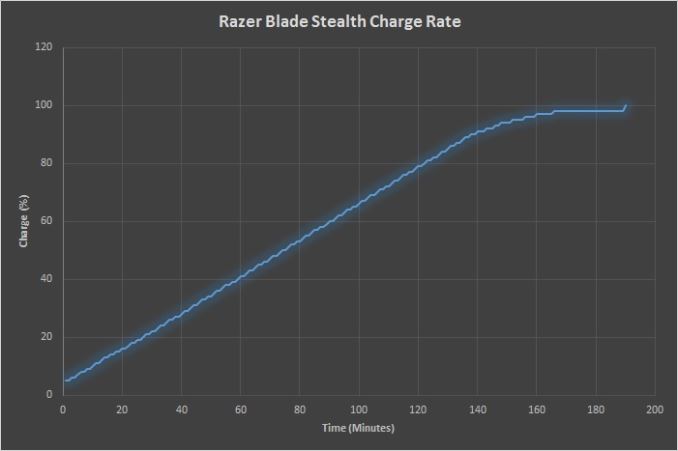








66 Comments
View All Comments
nerd1 - Tuesday, March 29, 2016 - link
Xps13 can be bought around 799 nowadaysBrokenCrayons - Tuesday, March 29, 2016 - link
“For Gamers. By Gamers.”Interplay, is that you in there? What happened to Van Buren?
retrospooty - Tuesday, March 29, 2016 - link
I never really got the need for a "gaming notebook". Gaming is far better, faster and cheaper on a desktop. Do alot of people really have the need to game when mobile? I would personally think most people, when out and about are doing whatever task they are out and about for, not worrying about gaming until they get home and have time for it. Is it just me? I guess if you travelled for work alot and wound up with extra time, but that screams niche market.BrokenCrayons - Tuesday, March 29, 2016 - link
Most mobile gaming I see happens on a phone and not on a laptop. There are most certainly a lot of people who spend time away from home due to work that might benefit from a gaming laptop, but this particular laptop isn't a gaming box without the not-so-mobile Razer Core and other external bits like a monitor, full sized keyboard, and mouse. The benefit in this to those sorts of people is that they only need to worry about one computer as opposed to a laptop and desktop. The Stealth's potential of using an external, desktop GPU offers some flexibility at an added cost. So yes, there's a point and yes its a niche market.The "but" in all of this is that the niche market might be larger than you think. People with no legitimate need for the capabilities the Stealth + Razer Core offers might still purchase such a setup or some other gaming laptop in order to have those capabilities. The expense could very well do nothing but address a psychological need that exists without reason purely inside the mind of the buyer. It happens pretty frequently in automotive markets where people buy much more capability than they need in order to be prepared to drive in weather or road conditions that happen for merely a day or two out of the year. They then willingly endure the liability of their purchase the other 363 days happily. Similarly a person with no need for a gaming laptop will be able to play games in a hotel room for a couple of days a year and deal with the cost and performance penalty of their purchase the rest of the time for little to no rational reason.
TheinsanegamerN - Tuesday, March 29, 2016 - link
There are people like me, that have LAN gaming parties. A laptop is so much more convenient. And I can play it at the laundromat when Im doing my laundry every weekend.I also live in a 1BD apartment. Space is at a premium, there is nowhere to put a nice computer desk for a desktop.
nerd1 - Tuesday, March 29, 2016 - link
Laptop is more convenient but you cannot play any real game on this laptop.BrokenCrayons - Wednesday, March 30, 2016 - link
I never understood what makes something "real" or not. Even a nearly ten year old GMA 950 can run games, some of which were flagship releases in the past. Does the age of a game make it lose it's connection with reality? Is something only "real" if it's been released in the last few months because humans can't fathom the relationship of the past to the present?DarkXale - Wednesday, April 6, 2016 - link
Depends on the definition of real.CS? It can handle.
LoL? It can handle.
DOTA2? It can handle. (Even benchmarked here at +60FPS)
WoW? It can handle.
Civilization 5/BE? It can handle.
Football Manager? It can handle.
Rocket League? It can handle.
You'd probably want to stay clear of Battlefield 4 or Witcher 3 - but at this point we're talking exceptions, not a norm.
DarkXale - Wednesday, April 6, 2016 - link
I should point out that I chose these titles since they're generally where you tend to see the most /played being done -today-.rxzlmn - Tuesday, March 29, 2016 - link
I don't think it's that uncommon for people to have jobs which require a decent amount of travelling. The main point is that it's easily transported from A to B, not that you can use it for gaming on the route itself. If you move, especially internationally, it makes sense. If you don't have a lot of space, it makes sense. If you want to have one main computer for both work and gaming, it makes sense (as a computer for work often has to be portable, i.e. bringing it to work places, meetings, on the plane, etc).I have a solid notebook that also happens to be powerful enough to run games, and nowadays the mobile GPU/CPUs are fast enough to run most games properly. Of course not with all the bells and whistles, but I can play most stuff on full HD and somewhat medium settings just fine, and my laptop only has a midrange mobile GPU.
Apart from myself opting for all the above mentioned benefits, I would also have to spend considerably more for a gaming capable desktop and a comparable non-gaming capable laptop together.